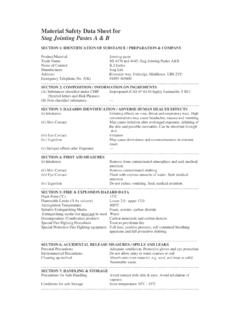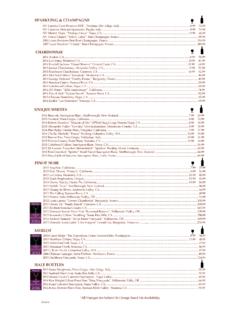Transcription of EAZA Hornbill Management and Husbandry …
1 eaza Hornbill Management and Husbandry guidelines 1st Edition, 2002 Compiled by Wieke Galama Catherine King Koen Brouwer eaza Hornbill Management and Husbandry guidelines 1st Edition, 2002 Compiled by Wieke Galama Catherine King Koen Brouwer Published by The eaza Hornbill TAG National Foundation for Research in Zoological Gardens c/o Amsterdam Zoo PO Box 20164 1000 HD Amsterdam The Netherlands Contact person Koen Brouwer Chair, eaza Hornbill TAG National Foundation for Research in Zoological Gardens email: or Cover illustrations from Kemp (1995) eaza Hornbill Management and Husbandry guidelines Contents Foreword 1) Natural history 2) Captive population Management Identification Morphology and sex determination Maturation and longevity European Hornbill collection plan taxa 3) Veterinary care, handling and transport Veterinary care Rodenticide poisoning Bill hygiene Treatment of bill and casque injuries Pseudotuberculosis (Yersiniosis) Other bacteria, parasites and fungal infections Iron storage disease Plumage condition Immobilization Physiological references Pathology review Handling and transport Quarantine Environmental enrichment and training 4)
2 Environmental conditions and housing Disturbance Mixed species enclosures Temperature Light regime Sprinkling and humidity Indoor or outdoor? Dimensions of the enclosure Boundary and floor materials Boundary (roof and wall) materials Floor (substrate) materials Furnishing of the enclosure Water source Vegetation Perches Nests Food tray and feeding Maintenance 5) Diet requirements Formulation of captive diets Fruits Palatability and Familiarity Colors Fiber Protein Calcium Iron Enrichment of the standard diet Diet changes during the breeding season Diet suggestions Food items Manufactured diets Gelatin cake 6) Reproduction Nesting cycle preparations Breeding behavior Nest Type of nest and nest materials Inside measurements Dimensions of the nest entrance Plastering the nest opening Nest lining Nest humidity and temperature levels Inspection door and observation devices Camera monitoring of nests Chick development and care Artificial incubation Hand-rearing Abnormal imprinting 7) Social behavior and pair/group composition Human- Hornbill interactions Introductions and pair formation Pair compatibility assessment Pair formation methods Sunda wrinkled Hornbill dating center at Heidelberg Zoo Great Hornbill breeding center at Arnhem Zoo Introductions Conspecific groupings and aggression 8)
3 Suggestions for research, public education and expanded guidelines Suggestions for research Dietary issues Color change of the circumorbital skin Reproductive physiology Life history and other physiological data Social and reproductive behavior studies Introductions and grouping strategies Artificial incubation techniques and hand-rearing Public education Future guidelines 9) Acknowledgements 10) References 11) Appendices European laboratories offering DNA feather sexing of birds Physiological reference ranges for Buceros bicornis (ISIS, 2002) Hornbill Pathology Report Form Experiences with hornbills in mixed-species enclosures Examples of diets fed to hornbills at successful zoos Asian Hornbill reproductive data/ Husbandry summary- Audubon Park Zoo Nest Entrance forms used by four Hornbill species in Thailand Data on artificial incubation of Hornbill eggs San Diego Zoo avian propagation center hand-rearing protocol Ethogram of social interactions Tables 1a.
4 Natural Hornbill temperature ranges 1b. Temperatures in Europe 2. Minimum and maximum daylight hours at various latitudes 3. Assignment of Hornbill species to feeding guilds 4. Food types and food item suggestions for captive diets 5. Some reproductive parameters for different Hornbill genera 6. Suggested measurements for artificial nest features Figures 1. Sunbathing 2. Bill cleaning 3. Average weekly food consumption rate during the breeding cycle of Buceros bicornis at Khao Yai Park (1981-1985). 4. Artificial nest with important features 5. Nest Investigation Tube Foreword How to use these guidelines The compilation of these guidelines started in 1996 with the distribution of the EEP Great Hornbill Management and Husbandry Questionnaire. Eighty-five percent of the 55 questionnaires sent to European and American zoos was completed and the resulting report (Galama, 1996b) was presented during the second International Hornbill Workshop 1997 in Malaga (Spain), organized by the eaza Hornbill TAG and the Buceros bicornis EEP species committee.
5 An international group of knowledgeable people working with hornbills in the field or in zoological institutions discussed and summarized suggestions for keeping and breeding hornbills successfully in captivity. As promised, but with quite a delay, the suggestions made during the International Hornbill Workshop, as well as other information that has become available in the interim, can now be shared with others through this document: The eaza Hornbill Husbandry and Management guidelines , First Edition, 2002. Successful breeding of most captive hornbills remains a challenge, and the scarce information available is scattered over the world. Therefore, the guidelines must be seen as a working document that tries to arrange known pieces of the puzzle.
6 Because we wanted to construct the guidelines so that the user only (usually) needs to refer to one section to answer a question, some pieces of information appear more than once in the guidelines . Other sections of the guideline are referred to if they give more or different information regarding a subject. Hopefully, the guidelines will help to improve Hornbill Husbandry and Management and will inspire the user to document new findings and to also make these available to others. The eaza Hornbill TAG is planning to produce a revision of the guidelines in 2004. We hope that users will send data, comments, suggestions and corrections on this first/draft version to the eaza Hornbill TAG chair Koen Brouwer for incorporation into the revision.
7 That version will hopefully be available via internet. 9 1 Natural history Hornbills have been held in zoos for more than a hundred years and have always been a great attraction. Their shape, flight and inquisitive behavior entice zoo visitors to slow their pace to watch these birds. Despite the evolution of zoos from "menageries" to present zoological institutions or conservation societies, successful breeding of many Hornbill species remains a challenge. The most striking physical similarity shared by the 54 recognized Hornbill species is the presence of a casque. All hornbills are hole nesters, and the females of all but two species are usually sealed-in the hole throughout incubation and most of the chick rearing. The extent of their collective range is fairly restricted, being almost entirely between 30 N and 30 S of the equator.
8 Hornbills do inhabit a variety of habitats, from dry savannas in Africa to rainforests of Asia and range from 100 g to 4 kg in mass. Zoo managers not only need to take into account the ecological and behavioral traits common to all hornbills, but also important species-specific variations. The suggestions given in the following chapters are based on general Hornbill natural history in general. These Hornbill Husbandry and Management guidelines are meant to compliment Alan Kemp's book "The Hornbills Bucerotiformes" published in 1995, which contains detailed information on each species' natural history and biology. Furthermore the guidelines follow the nomenclature of Kemp s book, as participants of the 2nd International Hornbill Workshop in 1997 agreed to use this nomenclature in future references.
9 Traditional common names of Buceros species are used here however. 10 2 Captive population Management Identification Conclusions on this topic were made during the International Hornbill Workshop 1997 in Malaga (Spain), and were originally summarized by Christine Sheppard. Large hornbills are rarely individually-marked in zoos because they are dimorphic and usually kept in pairs. However, if future, more intensive, population Management results in more Hornbill exchanges between institutions, all individuals should be readily identifiable. Transponders are useful, but can migrate or fail, and are unreadable unless a bird is very near the transponder reader. There have been no reports of significant problems with any type of metal leg band. Therefore it is recommended that these two marking systems, bands and transponders, are used simultaneously.
10 Transponders should be implanted in a Hornbill s right pectoral muscle. If possible, a second transponder should be implanted as a back up. The second transponder should be implanted in the left pectoral muscle as two transponders implanted in the same site can give hybrid readings. All hornbills should be ringed below the tarsometatarsal joint with metal bands engraved with identification numbers. Males should preferably be banded on the right, females on the left. While closed rings or bands, which cannot be removed without being destroyed, should ideally be used, other bands can be used when necessary. Young hornbills should be banded as soon as possible without disruption to Management . Transponder and band numbers and site of placement on the body should be included in the bird's records.




